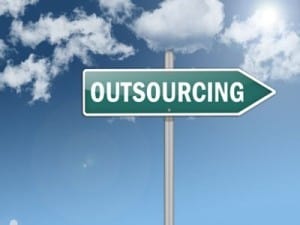
I believe it was Peter Drucker who opined about outsourcing and then wrote a book on the subject. The original premise was that low-level administrative functions that were not a key or core focus of the business (such as mail rooms) could be outsourced. Fast forward several years, and business has learned that virtually all non-value add functions can be outsourced.
IT infrastructure was value add as long as something new or better could be developed to provide cost savings, efficiencies, and improvements. Now that technology is becoming more costly with lower returns, IT departments are moving into full-blown maintenance mode. They are becoming the modern day mail rooms that companies outsource for lower cost to focus on more fundamental or core business requirements. IT departments have allowed themselves to become administrative overhead and a key target for cost reduction.
This outsourcing trend has focused primarily on infrastructure tasks such as network monitoring, database administration, email system maintenance, and OS and Office application rollouts. With all of the hype around cloud computing, or what used to be referred to as “ASP” (Application Service Providers), or application hosting this trend will accelerate.
I see this same trend beginning to occur in the business application space as well. The business application functions are moving into maintenance mode and slowly being outsourced. Many companies have automated, streamlined, and process improved functions that support the supply chain so that they are now mature. With that maturity, the last mile of improvement becomes cost prohibitive with little payback. For more insight on this topic please see the following posts:
Competitive Pressures and Value Propositions, Is Lean the Answer?
Business and IT Alignment – Integrating Technology and IT Spend with Business
Operational technology adoption generally follows a fairly consistent adoption model:
- Implement
- Stabilize
- Improve
- Maintain
As soon as maintenance operations begin to stabilize, and as the processes and support requirements are finalized, the IT area becomes a prime target for outsourcing.
Future IT Application Alignment and Trends
The next few years of the application space will see a major separation of consultants, vendors, applications, and solutions around operations, sales, and new products/services. Forward-looking IT organizations will be those who can move into the “value add” areas of the enterprise to support and automate sales, marketing, engineering (i.e. innovation functions), etc. The losers will be those who continue to focus on operations after the initial low hanging fruit has been picked.
For those in IT areas, lead, follow, or get out of the way (or you will be run over!).
As an IT leader, if you want to avoid obsolescence and outsourcing, then you need to retool your organization with the best and the brightest to begin focusing on the customer and innovation portions of the business. Once operations are well underway, the next phase for the successful IT leader who does not want to face outsourcing their department, and possibly their own job, is to partner with the sales, marketing, and engineering sides of the business for long-term success.
The Operational CIO Must Become a Strategic CIO
The past business application focus has seen a focus on finance and operations. Key metrics in the past have included improving month-end close times, reducing various supply chain cycle times, and overall view of operational and financial data in real time. These are all the lagging indicator side of the business, which is focused on the CFO/COO side of the business. Now however, application vendors as well as consulting companies need to begin focusing aggressively on the sales, marketing, and innovation/engineering portions of the business. Or, in business terms, the leading indicator portion of the business.
The successful CIO of tomorrow will be the one who builds a bridge with technology solutions between the CEO and the CFO/COO. Those CIOs (and by proxy their subordinate IT leaders) who make that transition to covering the holistic business will see their career prospects flourish. Those who do not will be stagnate and find tremendous budget pressure slowly collapsing their organizations. I have penned a few articles on this topic as well, which explain the changing dynamic for the CIO and the future of the application space. Here is a short piece that explains that new relationship in more detail:
What is the Proper Relationship for the CIO, CEO, and CFO?
A permanent change in today’s business and consumer landscape is leading to a permanent change in IT staffing and project work in SAP and all other commercial applications. You can either plan for it, adjust to it, and then learn to work within the coming paradigm– or you can be run over by it. Global economic conditions and the near financial collapse have created a permanent change in how businesses operate and customers purchase. Financial institution regulatory controls have closed the door to many of the previous credit holes that allowed some of the out-of-control speculative and self-indulgent spending by consumers. That trend will likely not change for many years. It is even less likely to return to the days of free-flowing credit and consumer spending binges that fueled so many speculative bubbles.





